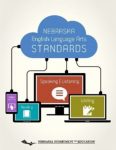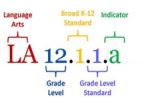2014 ELA Standard
2014 English Language Arts Standards
Nebraska’s College and Career Ready Standards for English Language Arts
Adopted by the State Board of Education on September 5, 2014
 2014 ELA Standards (vertical) (pdf)
2014 ELA Standards (vertical) (pdf)
2014 ELA Standards (horizontal) (pdf)
An Overview of ELA Standards:
Standards establish what students should know and be able to do by the end of a specified grade level. English Language Arts (ELA) standards are created and revised by stakeholders across the state, and are adopted by the Nebraska State Board of Education at the end of a 7-year cycle. The standards challenge students to develop the essential literacy skills needed to succeed in college, career, and life. They cover a broad array of core knowledge and proficiencies in areas such as reading, writing, and listening and speaking. For more information, please download the FAQs for 2014 ELA Standards
Nebraska’s standards are organized with three levels of specificity:
- K-12 Comprehensive Statements – Identify broad, general statements that are not grade-level specific and cover big ides in English Language Arts (Reading, Writing, Speaking and Listening, and Multiple Literacies.)
- Grade-Level Expectations – Statements that identify what students should know and be able to do by the end of each identified grade/band. These are organized into categories, but not course specific.
- Curricular Indicators – Specific information to distinguish expectations between grade levels. They are no longer simply examples, but are considered an integral part of the standard to be taught.
Nebraska has historically been a local control state with no mandated curriculum or textbooks. The standards are not meant to be a curriculum. Rather, districts are expected to align their local curriculum to the Nebraska Standards to add more specificity. Nebraska’s draft standards are written using verbiage that describes the knowledge and skills students are expected to master at the various grade levels rather than using performance expectation language. Districts also have the choice to adopt their own standards only if they are more rigorous than the state standards.
The numbering system is illustrated in this graphic:





